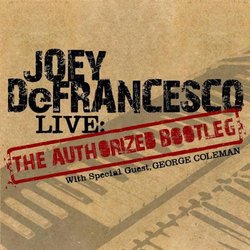| All Artists: Joey Defrancesco Title: Live: The Authorized Bootleg Members Wishing: 3 Total Copies: 0 Label: Concord Records Original Release Date: 1/1/2007 Re-Release Date: 3/6/2007 Genres: Jazz, Pop Styles: Modern Postbebop, Bebop Number of Discs: 1 SwapaCD Credits: 1 UPC: 888072301238 |
Search - Joey Defrancesco :: Live: The Authorized Bootleg
 | Joey Defrancesco Live: The Authorized Bootleg Genres: Jazz, Pop
|
Larger Image |
CD Details |
CD ReviewsA Killer CD D. Berryman | Minneapolis, MN United States | 03/08/2007 (5 out of 5 stars) "The Authorized Bootleg, opens with a bang with "Cherokee", Coleman opens with an engaging solo intro and then ups the tempo as he brings in the band and continues to tear it up with about four minutes of amazing choruses Then Joey answers with a blistering solo of his own. The CD continues to explore standards with astonishing originality and passion. Even at 70, George Coleman is a monster on tenor and Joey gives plenty of space to him throughout. Coleman is featured heavily on this CD, but don't forget that Joey is the greatest B3 player in the world and this band is arguably the best jazz organ trio playing today. They are so tight they can relax enough to explore the beauty of these standards with spontaneity and imagination. "These songs have been played a million times," says DeFrancesco in the liner notes, "but the level of live playing here is what gives the music its bebop and post-bebop beauty. We're all playing in the moment--balls to the wall." Live: The Authorized Bootleg is one of the best recordings I have heard in quite a while. I strongly recommend it." Musical Cage Fighting: Few Holds Barred Samuel Chell | Kenosha,, WI United States | 08/16/2008 (4 out of 5 stars) "DeFrancesco definitely deserves credit for recognizing and showcasing some comparatively neglected authoritative voices on the music scene, from Mort Weiss to Houston Person. George Coleman first came to jazz followers' notice playing alto on a 1950s Lee Morgan Blue Note session arranged by Benny Golson. He appeared slightly ahead of the arrival of Wayne Shorter yet even today is likely to strike some listeners as the stronger of the two creative tenor voices. In fact, the recent release of a Miles Davis date featuring Coleman with Herbie, Tony, and Ron Carter at Monterey is sufficiently arresting to cause a listener to wonder why Miles saw fit to replace him. While Shorter stayed with Blakey into the mid-1960s, then began to explore a more abstract and, at least with Weather Report, commercial dimension of the music, Coleman played it close to the center, fanning the flames of hard bop in Village quintets with frontline partner trumpeter Danny Moore (whatever happened to him?) and New York power pianist Harold Mabern.
Always an imposing physical specimen, Freeman appears to have kept himself in shape musically as well. His favoring of the treble register of the horn is, as usual, in evidence throughout, To my ears, he's of late introduced a degree of overcompensating, or 'forced," support to his tones, which once bore a striking resemblance to the effortless altissimo of Coltrane. Still, one could argue that the extra rawness and power make him a better complement to the undeniably eruptive rhetoric of DeFrancesco's B3. Whereas formerly Coleman was a player who "invited" the listener to discover the beauty of his conceptions, he plays on this date, as DeFrancesco at one point acknowledges, like a man who "means business." The tones are frequently raw, impassioned cries, the altissimos playing not merely to the back row at Yoshi's but entering some vibrational sonic field that rings quantum mechanical physics as much as shoutin', tough-tenor soul. The program opens fearlessly with a way-up "Cherokee" and adheres throughout to a mainstream melodic/harmonic line. Rather than attempt to run the changes and keep up with the rapid-fire articulations that a bop-minded player, or even a younger Coleman, might find hard to resist, he opportunistically chooses his spots, frequently climaxing in the outer spatial regions of the horn's reach, even concluding a phrase with a phase-shifting, alternate-fingered version of the same top tone. Perhaps he's least effective on Lee Morgan's "Ceora," a tuneful meditation so artfully constructed by the trumpeter that it readily proves uncooperative if excessively tampered with. This tune almost breaks down for me, but the rest of the way, the venerable but indomitable tenor saxophonist stands up to both the heavy-duty invention by Mr. Hammond and the redoubtable playing by its formidable present-day operator as though the outcome were a foregone conclusion: As anyone should know, Coleman seems to be saying, if you plan on having a musical street fight (or even a lively husband-wife conversation) and one of the pair is brandishing a Hammond B3, never bet against the guy with a Selmer Mark VI." |

 Track Listings (7) - Disc #1
Track Listings (7) - Disc #1